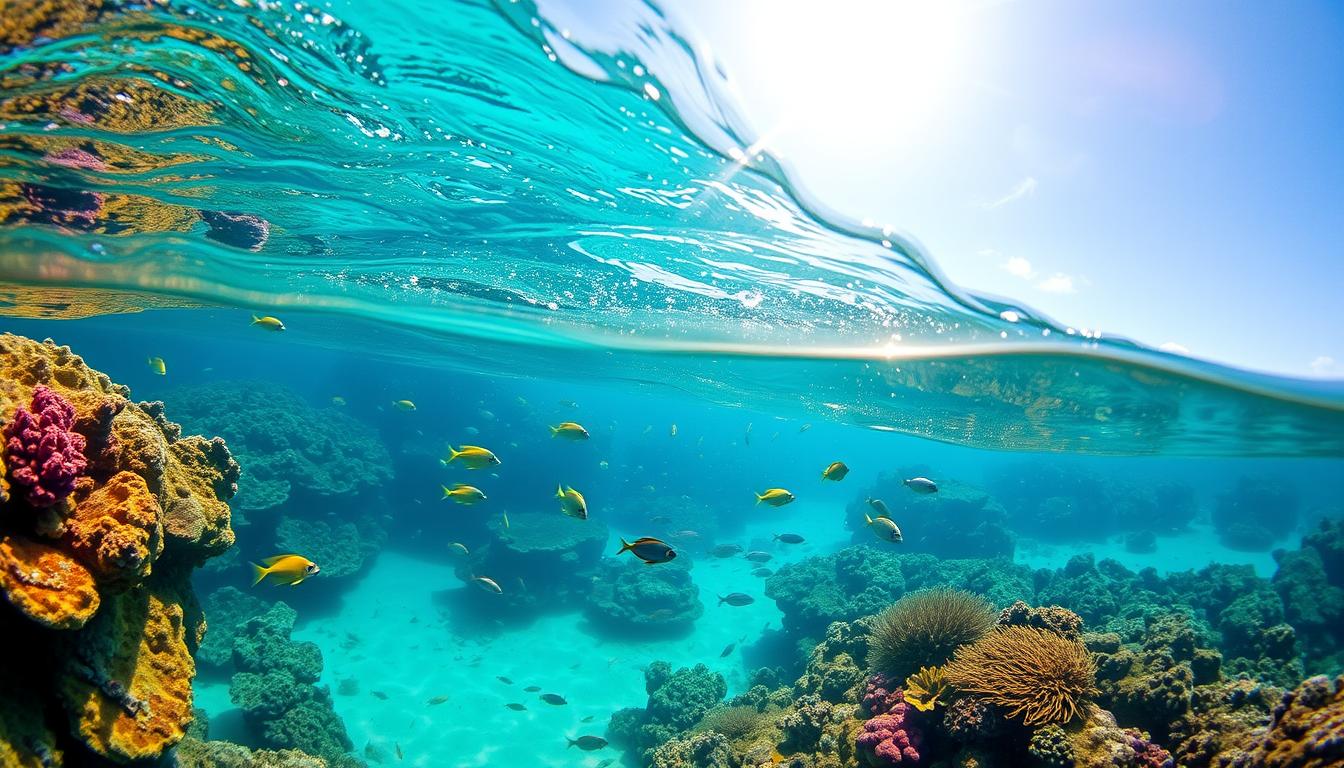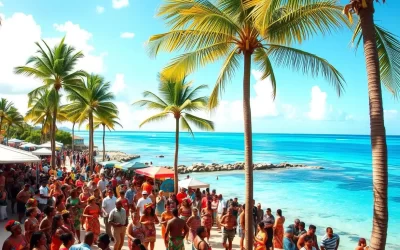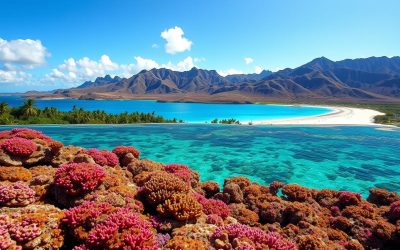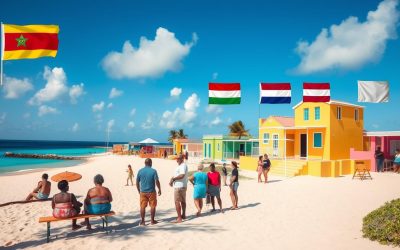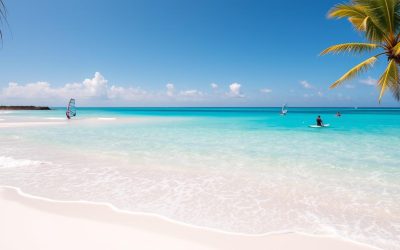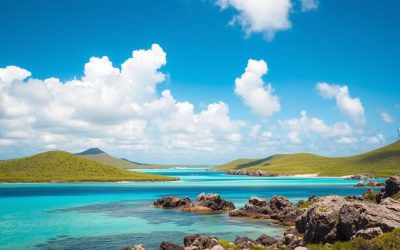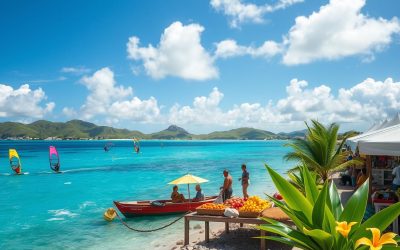Imagine a Caribbean island where the whole coast is a protected marine park. It’s a paradise for nature lovers, divers, and snorkelers. Welcome to Bonaire, a Dutch part of the Leeward Antilles. The Bonaire National Marine Park covers the entire coast, including Klein Bonaire.
This marine ecosystem goes up to 300 meters out to sea. It reaches depths of 60 meters. It’s a true underwater paradise.
But why should you visit the Bonaire National Marine Park? What makes it so special? Let’s explore the wonders waiting for you in this Caribbean gem.
Key Takeaways
- The Bonaire National Marine Park covers the entire coastline of the island, including the small island of Klein Bonaire.
- The park’s coral reef extends up to 300 meters offshore and can reach depths of 60 meters.
- Diving and snorkeling spots within the park are marked with painted yellow rocks to guide visitors.
- The Bonaire National Marine Park is a top tourist attraction on the island, renowned for its diverse marine life and exceptional diving and snorkeling opportunities.
- The park’s protected status ensures the preservation of Bonaire’s unique natural resources for generations to come.
What secrets does the Bonaire National Marine Park hold? How can you dive into its captivating underwater world? Read on to find out the best things to do and top picks for your Bonaire adventure.
Introduction to Bonaire’s Natural Paradise
The island of Bonaire is a true eco-tourism gem in the southern Caribbean Sea. It covers almost 290 square kilometers. This island is full of natural wonders, making it a marine conservation haven.
Location and Marine Park Overview
Bonaire is in the Lesser Antilles but belongs to the Netherlands. It’s about 8,000 kilometers from Europe. The Bonaire National Marine Park, started in 1979, protects Bonaire’s coast and Klein Bonaire. It keeps the marine ecosystem diverse.
Conservation Significance
Bonaire is serious about conservation. It has strict rules and programs for visitors. The island has about 10,000 flamingos and reefs with 60 coral species. It’s a natural paradise for exploration.
Brief History of the Marine Park
The Bonaire National Marine Park began in the 1960s. It was due to worries about overfishing and coral damage. Now, it helps keep Bonaire’s marine environment balanced and supports eco-tourism.
Getting Started: Essential Information for Visitors
Starting your Bonaire adventure needs some key steps. First, you must buy a nature fee tag to visit the Bonaire National Marine Park. This fee supports the park’s conservation and keeps the island’s ecosystems safe. Divers also need to take a short orientation at a local dive shop. This helps them understand the park’s rules and the underwater world.
Getting around Bonaire is easy, thanks to its main spots being in the north and south. Renting a car is a great idea to see the island at your own speed. Bonaire welcomes visitors all year, but the best weather is from December to April.
When exploring Bonaire, always be eco-friendly. Dispose of waste properly, respect wildlife, and try not to harm the marine and land environments. These actions help keep Bonaire beautiful for future visitors.
- Purchase a nature fee tag to access the Bonaire National Marine Park
- Complete a dive shop orientation for familiarization with park rules and conditions
- Rent a car for convenient exploration of the island’s north and south attractions
- Plan your visit during the peak season from December to April for optimal weather
- Adopt eco-friendly behaviors to help protect Bonaire’s natural wonders
“Bonaire’s commitment to sustainability sets it apart as a truly remarkable destination. By respecting the island’s delicate ecosystem, visitors can enjoy an unforgettable experience while contributing to its long-term preservation.”

Diving and Snorkeling Highlights
Bonaire is known as the “Diver’s Paradise.” It offers a top-notch underwater experience for divers and snorkelers. With over 60 shore dive sites, it’s the #1 spot for shore diving worldwide. The clear waters, colorful marine life, and protected reefs make it a natural wonder.
Popular Dive Sites
Some famous dive sites in Bonaire include the Hilma Hooker wreck and the Salt Pier. You can also dive at Karpata reef. Divers love Alice in Wonderland and Klein Bonaire for their clear waters and diverse marine life.
Marine Life Encounters
The underwater world of Bonaire is full of marine species. You can see parrotfish, sea turtles, and seahorses. The reefs are perfect for underwater photography, with many coral species.
Equipment and Safety Guidelines
Bonaire has a well-developed diving infrastructure. Dive shops offer rentals and guided tours. Always use reef-safe sunscreen and avoid touching marine life. Proper training and certification are key for a safe dive or snorkel.
| Dive Site | Highlights |
|---|---|
| Hilma Hooker | Wreck dive with abundant marine life |
| Salt Pier | Unique underwater salt structures and diverse marine ecosystems |
| Karpata | Pristine coral reefs and excellent visibility |
| Alice in Wonderland | Vibrant coral formations and schooling reef fish |
| Klein Bonaire | Remote islet with exceptional underwater visibility and wildlife |

“Bonaire’s underwater world is a true marvel, offering a diverse array of marine life and well-preserved coral reefs accessible from the shore. It’s a diver’s and snorkeler’s paradise.”
Coastal Attractions and Beach Activities
Bonaire’s stunning coastline is full of attractions for visitors. You can enjoy world-class Bonaire beaches, exciting water sports, and beautiful coastal exploration. The island’s shores offer an unforgettable experience.
Lac Bay and Sorobon Beach are top spots for windsurfing. They attract windsurfers from all over. The trade winds and clear waters are perfect for all levels.
No Name Beach on Klein Bonaire island is great for snorkeling. You can see diverse marine life and stunning coral formations just below the surface.
Explore Bonaire’s rugged east coast for breathtaking views and scenic drives. You can see iconic pink flamingos along the coast. Also, check out the historic slave huts in the southern salt pans.
Beach activities are endless. You can sunbathe, beachcomb, or kayak through mangrove forests.
| Coastal Attraction | Highlight |
|---|---|
| Lac Bay | Premier windsurfing destination |
| Sorobon Beach | Excellent windsurfing conditions |
| No Name Beach (Klein Bonaire) | Superb snorkeling opportunities |
| East Coast Scenic Drives | Rugged landscapes and historical sites |
| Southern Salt Pans | Observe flamingos and explore slave huts |
Bonaire’s diverse Bonaire beaches, exciting water sports, and captivating coastal exploration make it a must-visit. It offers an unforgettable adventure for all travelers.

Bonaire National Marine Park, Bonaire: Best Things to Do – Top Picks
Bonaire’s National Marine Park is a treasure trove of activities for those who love the sea. You can join sea turtle patrols or help with coral restoration. These are great ways to help the marine life during your visit.
Marine Conservation Activities
Sea Turtle Conservation Bonaire leads patrols on the beaches. They watch over the sea turtles’ nesting sites. Visitors can join these patrols and see the sea turtles’ journey to the ocean.
The Reef Renewal Foundation Bonaire lets you help restore the coral reefs. You can plant and transplant coral. It’s a chance to learn about coral conservation and the foundation’s work.
Guided Tours and Programs
Bonaire’s eco-tours are a great way to see the marine park. Glass-bottom boat tours let you see the underwater world without getting wet. Snorkeling excursions give you a closer look at the marine life.
Mangrove kayak tours are also popular. They let you explore the mangrove forests. You’ll see how these forests are vital for the island’s marine conservation.
Educational Opportunities
The Mangrove Info Center in Bonaire is a place for learning. It offers educational programs on marine ecology and conservation. You can attend sessions, see interactive exhibits, and learn about protecting Bonaire’s marine environment.
Local dive shops also have educational programs. They focus on the unique biodiversity and conservation efforts in the Bonaire National Marine Park.

Land-Based Adventures and Sightseeing
Bonaire’s wonders go beyond its famous marine park. Explore the island’s land to find many adventures and cultural spots. These show off Bonaire’s varied beauty and rich history.
Check out the Bonaire National Park for hiking trails and stunning views. Climb Brandaris, the highest spot, for amazing views. Visit Rincon, the oldest village, for its colorful buildings, shops, and history.
Try local drinks at the Cadushy Distillery. Learn how Bonaire’s famous liquor is made. The Bonaire Museum tells the island’s story through exhibits on its past, culture, and history.
- Explore the diverse landscapes of the Bonaire National Park, including hiking trails and the highest point, Brandaris.
- Discover the historic charm and cultural attractions of Rincon, the oldest settlement on the island.
- Visit the Cadushy Distillery to learn about the production of Bonaire’s signature liquor.
- Delve into the island’s rich history and heritage at the Bonaire Museum.
Bonaire is great for those who love adventure. Try cave tours, mountain biking, or landsailing. It’s a place full of exciting activities for everyone.
| Activity | Location | Description |
|---|---|---|
| Hiking | Bonaire National Park | Discover diverse landscapes and scenic vistas on the park’s hiking trails. |
| Cultural Exploration | Rincon | Immerse yourself in the history and vibrant culture of Bonaire’s oldest village. |
| Distillery Tour | Cadushy Distillery | Learn about the production of Bonaire’s signature liquor and sample local spirits. |
| Museum Visit | Bonaire Museum | Explore the island’s natural history, indigenous culture, and colonial heritage. |
Wildlife and Nature Photography Opportunities
Bonaire is a paradise for nature photographers. It has diverse landscapes and lots of wildlife. You can see colorful flamingos at Goto Lake and explore the rugged terrain of Washington-Slagbaai National Park. The coastline is perfect for capturing aerial shots of seabirds.
Best Photography Locations
Goto Lake is a must-see for Bonaire wildlife lovers. It’s filled with thousands of flamingos, making for beautiful photos. The Washington-Slagbaai National Park offers a mix of cacti fields and cliffs, great for both landscapes and wildlife nature photography.
Seasonal Wildlife Highlights
- Nesting sea turtles from May to October
- Migrating birds in the winter months
Photography Tips and Guidelines
Respecting Bonaire’s ecosystems is key when taking photos. Use zoom lenses to keep a safe distance from animals. Also, follow all park rules to protect these habitats. Underwater photography is also exciting, with colorful reefs and marine life.
By following these tips and exploring Bonaire’s wildlife and nature photography spots, you can take amazing photos. These images will inspire others to see Bonaire’s natural beauty.
Practical Tips and Conservation Guidelines
As you explore Bonaire National Marine Park, adopt eco-friendly habits. Use reef-safe sunscreen to protect the coral reefs. These reefs are the heart of this natural wonder.
Proper waste disposal is key. Look for recycling bins and don’t litter. This keeps Bonaire’s beaches and waters clean. Also, save water by turning off taps and using a reusable water bottle.
- Use reef-safe sunscreen to protect the coral reefs
- Dispose of waste properly and recycle whenever possible
- Conserve water by turning off taps and using reusable bottles
Bonaire goes beyond individual actions for conservation. It supports sustainable tourism with beach clean-ups and coral restoration. Visitors can help by joining volunteer activities or choosing eco-certified tours.
Respecting nature and wildlife is crucial. Keep a safe distance from animals, avoid disturbing their homes, and follow park guidelines. Your eco-friendly actions and responsible behavior will help preserve Bonaire’s beauty for future generations.
| Eco-Friendly Travel Tips | Bonaire Conservation Efforts | Sustainable Tourism Opportunities |
|---|---|---|
|
|
|
“Bonaire’s commitment to conservation is reflected in its strict environmental regulations and visitor education programs.”
Conclusion
Bonaire’s National Marine Park is a treasure trove of natural wonders and adventure. It’s perfect for those who love diving, snorkeling, and exploring nature. Here, you can dive into vibrant coral reefs and enjoy land activities too.
By joining in on conservation efforts, you help protect Bonaire’s beauty for the future. This makes your trip not just fun but also meaningful. It’s a chance to see the island’s stunning sights and help preserve it.
Explore Bonaire’s marine life and history. Try exciting activities like landsailing and spirit tastings. See the salt pyramids and the slave huts, and enjoy views from Seru Largu.
Kralendijk, with its lively streets and buildings, adds to the charm of your visit. It’s a great place to start your Caribbean adventure.
Bonaire’s National Marine Park is ideal for all kinds of travelers. Whether you dive, snorkel, or love nature, you’ll find something special here. It’s a place where eco-tourism and marine conservation meet, offering unforgettable experiences.
The above is subject to change.
Check back often to TRAVEL.COM for the latest travel tips and deals.
